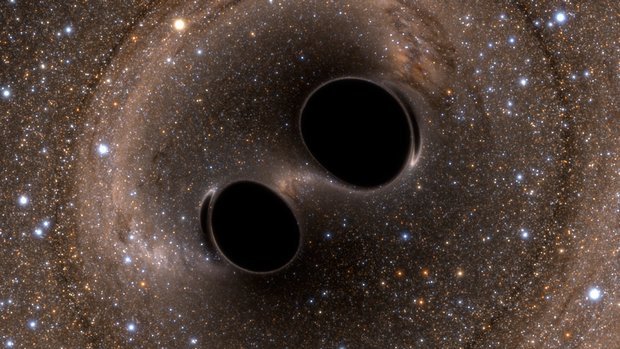Merger of two black holes has three stages: inspiral, merger and ringdown phases. Characteristic gravitational waves are emitted in each phase. The last ringdown phase is very brief and encode information about properties of final black hole. Reanalysis of data from binary black hole merger event GW190521 has provided, for the first time, evidence of signature aftershocks of the merger in the form of two separate faint ringdown frequencies produced by the resulting single black hole as it settled down to a stable symmetrical form. This is the first detection of multiple gravitational-wave frequencies in the ringdown stage. Just like a bell ‘rings’ for some time after being stuck, the resulting single distorted black hole formed after the merger ‘rings’ for some time emitting faint gravitational waves before achieving symmetrical stable form. And, just the way shape of the bell determines the specific frequencies with which the bell rings, similarly, as per no-hair theorem, mass and spin of the black hole determine ringdown frequencies. Hence, this development paves the way for use of ringdown frequencies to study properties of final black hole.
Black holes are massive objects with extremely strong gravitational fields. When two orbiting black holes spiral around each other and eventually coalesce, the fabric of space-times around them are disturbed that creates ripples of gravitational waves radiating outwards. Since September 2015 when gravitational-wave astronomy began with LIGO’s first detection of gravitational waves generated by merger of two black holes 1.3 billion light years away, merging black holes are now routinely detected almost once every week.
The merger of black holes has three phases. When the two black holes are widely separated, they slowly orbit each other emitting weak gravitational waves. The binary gradually moves to smaller and smaller orbits as the energy of the system is lost in the form of gravitational waves. This is inspiral phase of coalescence. The next is merger phase when the two black holes get close enough to coalesce to form a single black hole with distorted shape. Strongest gravitational waves (GWs) are emitted at this stage which are now routinely detected and recorded by gravitational-wave observatories.
The merger phase is followed by a very short stage called ringdown stage wherein the resulting single distorted black hole quickly achieves more stable spherical or spheroidal form. Gravitational waves emitted in the ringdown phase are damped and much fainter than the GWs released in the merger phase. Just as a bell ‘rings’ for some time after being stuck, the resulting single black hole ‘rings’ for some time emitting much fainter gravitational waves before achieving symmetrical stable form.
The faint multiple ringdown frequencies of gravitational waves released during the ringdown phase of merger of two black holes were undetected so far.
A research team has recently been successful in detecting multiple gravitational-wave frequencies in the ringdown stage of binary black hole merger event GW190521. They searched for individual fading tones in the ringdown frequencies without considering any relation with frequencies and damping times and were successful in identifying two modes implying the resulting deformed black hole emitted at least two frequencies after the merger. This was predicted by Einstein’s general relativity hence the result confirms the theory. Further, researchers compared the frequencies and damping times of the two ringdown modes found in the merger event to test the “no-hair theorem” (that black holes are completely characterised by mass and spin and no other “hair” is needed to describe its features) and found nothing beyond general relativity.
This is a milestone because it was widely thought that observation of multiple ringdown frequencies would not be possible before next generation gravitational-wave detectors become available in the future.
***
Sources:
- Capano, C. D. et al. 2023. Multimode Quasinormal Spectrum from a Perturbed Black Hole. Physical Review Letters. Vol. 131, Issue 22. 1 December 2023. DOI: https://doi.org/10.1103/PhysRevLett.131.221402
- Max-Planck-Institut fürGravitationsphysik(Albert-Einstein-Institut), 2023. News – For whom the black hole rings. Available at https://www.aei.mpg.de/749477/for-whom-the-black-hole-rings?c=26160
***






































